Cultural Intelligence: Workforce Diversity and Team Integration
VerifiedAdded on 2022/10/12
|18
|4314
|395
Report
AI Summary
This report delves into the significance of cultural intelligence (CQ) in managing workforce diversity and fostering team integration within multicultural environments. It begins by establishing the research problem, which centers on effectively managing diverse teams in a globalized business landscape. The literature review explores the importance of CQ in enhancing team management abilities, highlighting the interrelationship between CQ and multicultural teams. The research methodology outlines the chosen philosophy, approach, design, data collection methods, and ethical considerations. Expected results and prospective contributions are discussed, emphasizing the potential for improved team performance, communication, and adaptability in diverse settings. The report aims to provide valuable insights into the practical application of CQ for organizations seeking to optimize their multicultural teams.
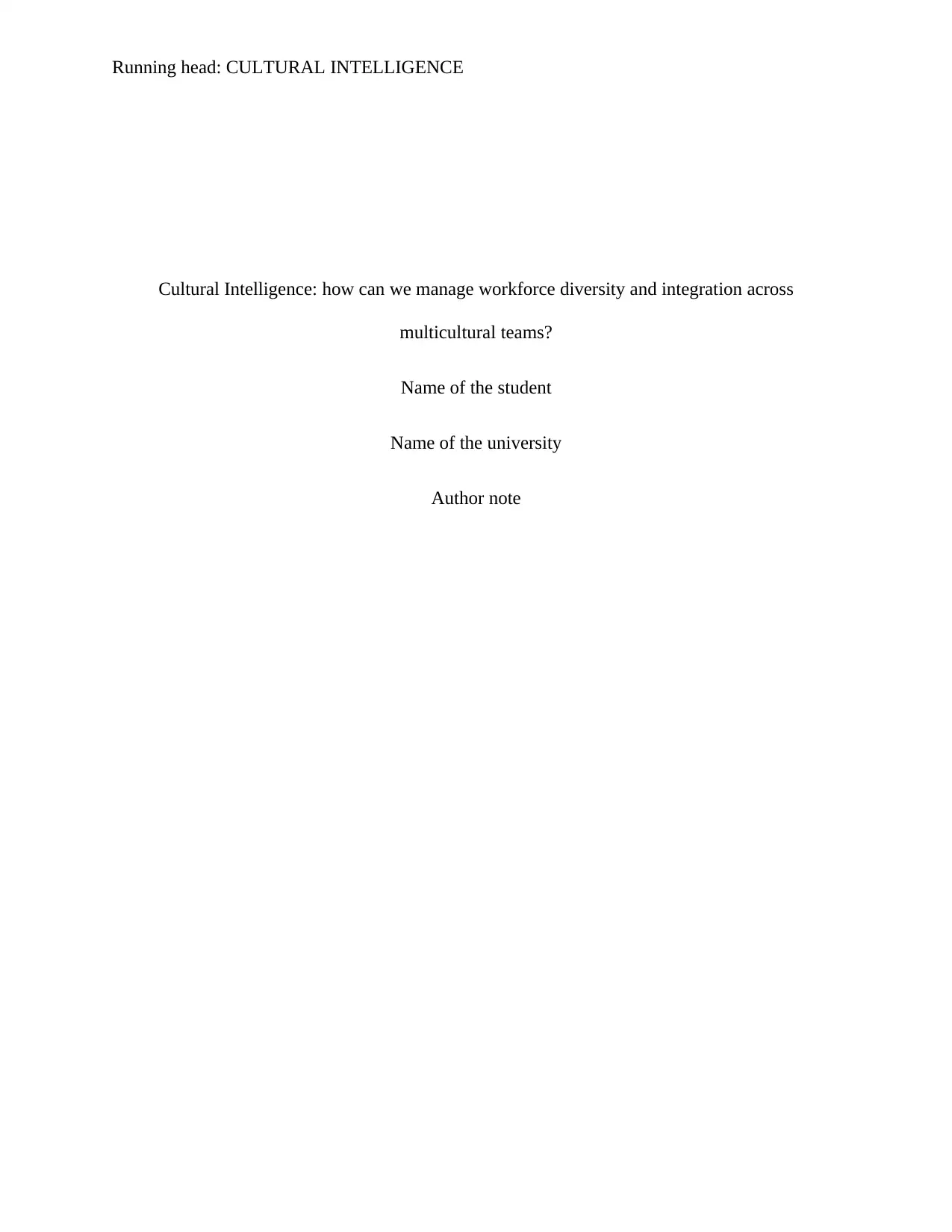
Running head: CULTURAL INTELLIGENCE
Cultural Intelligence: how can we manage workforce diversity and integration across
multicultural teams?
Name of the student
Name of the university
Author note
Cultural Intelligence: how can we manage workforce diversity and integration across
multicultural teams?
Name of the student
Name of the university
Author note
Paraphrase This Document
Need a fresh take? Get an instant paraphrase of this document with our AI Paraphraser
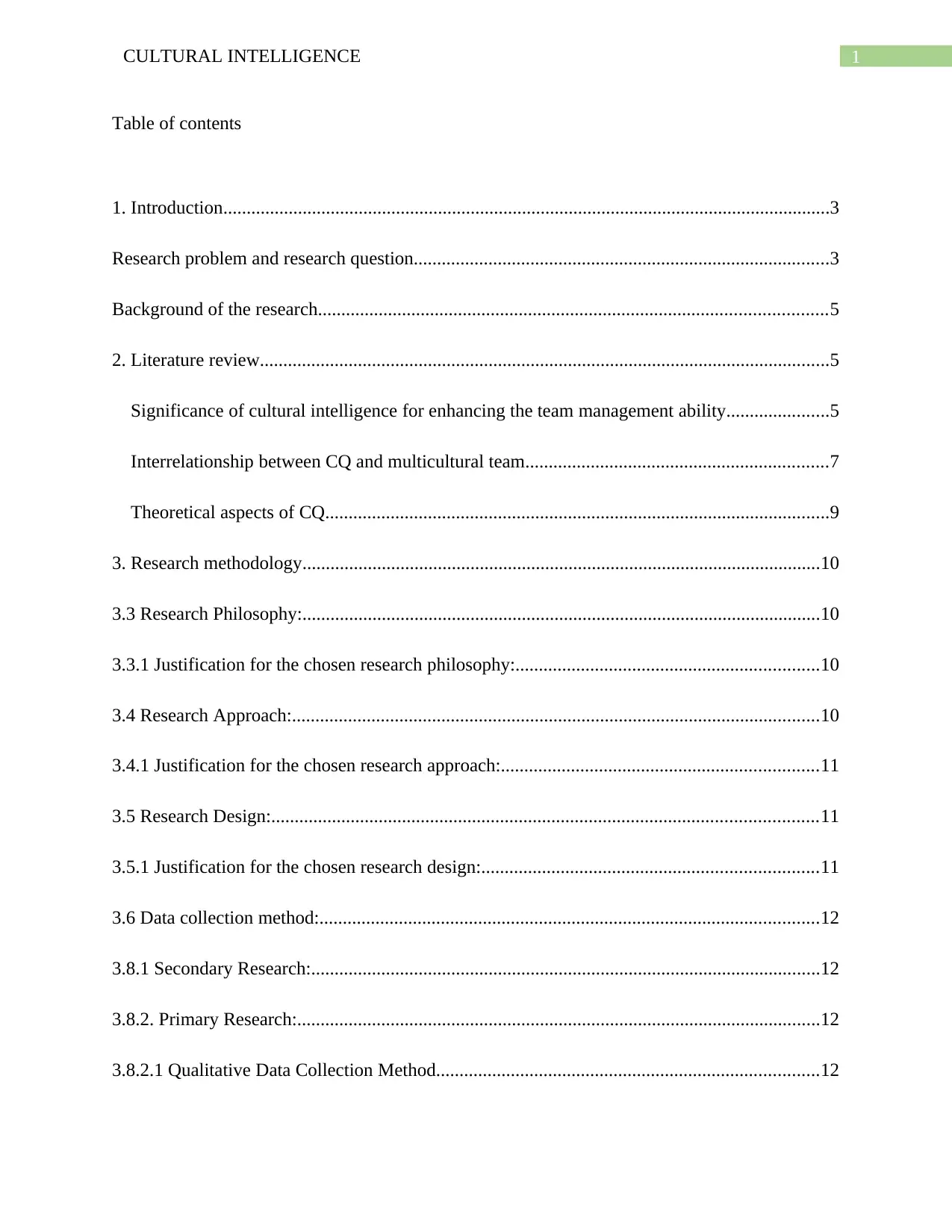
1CULTURAL INTELLIGENCE
Table of contents
1. Introduction..................................................................................................................................3
Research problem and research question.........................................................................................3
Background of the research.............................................................................................................5
2. Literature review..........................................................................................................................5
Significance of cultural intelligence for enhancing the team management ability......................5
Interrelationship between CQ and multicultural team.................................................................7
Theoretical aspects of CQ............................................................................................................9
3. Research methodology...............................................................................................................10
3.3 Research Philosophy:...............................................................................................................10
3.3.1 Justification for the chosen research philosophy:.................................................................10
3.4 Research Approach:.................................................................................................................10
3.4.1 Justification for the chosen research approach:....................................................................11
3.5 Research Design:.....................................................................................................................11
3.5.1 Justification for the chosen research design:........................................................................11
3.6 Data collection method:...........................................................................................................12
3.8.1 Secondary Research:.............................................................................................................12
3.8.2. Primary Research:................................................................................................................12
3.8.2.1 Qualitative Data Collection Method..................................................................................12
Table of contents
1. Introduction..................................................................................................................................3
Research problem and research question.........................................................................................3
Background of the research.............................................................................................................5
2. Literature review..........................................................................................................................5
Significance of cultural intelligence for enhancing the team management ability......................5
Interrelationship between CQ and multicultural team.................................................................7
Theoretical aspects of CQ............................................................................................................9
3. Research methodology...............................................................................................................10
3.3 Research Philosophy:...............................................................................................................10
3.3.1 Justification for the chosen research philosophy:.................................................................10
3.4 Research Approach:.................................................................................................................10
3.4.1 Justification for the chosen research approach:....................................................................11
3.5 Research Design:.....................................................................................................................11
3.5.1 Justification for the chosen research design:........................................................................11
3.6 Data collection method:...........................................................................................................12
3.8.1 Secondary Research:.............................................................................................................12
3.8.2. Primary Research:................................................................................................................12
3.8.2.1 Qualitative Data Collection Method..................................................................................12
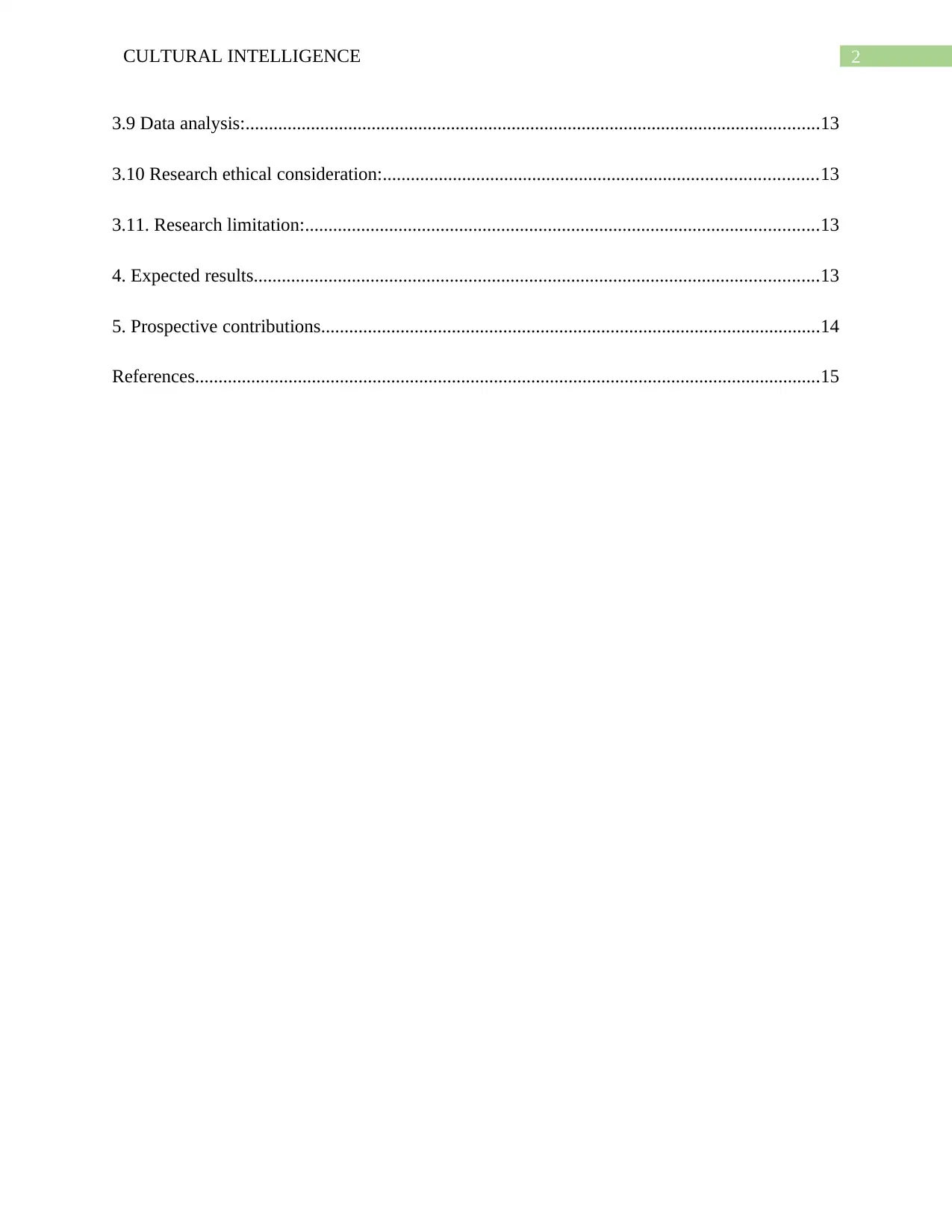
2CULTURAL INTELLIGENCE
3.9 Data analysis:...........................................................................................................................13
3.10 Research ethical consideration:.............................................................................................13
3.11. Research limitation:..............................................................................................................13
4. Expected results.........................................................................................................................13
5. Prospective contributions...........................................................................................................14
References......................................................................................................................................15
3.9 Data analysis:...........................................................................................................................13
3.10 Research ethical consideration:.............................................................................................13
3.11. Research limitation:..............................................................................................................13
4. Expected results.........................................................................................................................13
5. Prospective contributions...........................................................................................................14
References......................................................................................................................................15
⊘ This is a preview!⊘
Do you want full access?
Subscribe today to unlock all pages.

Trusted by 1+ million students worldwide
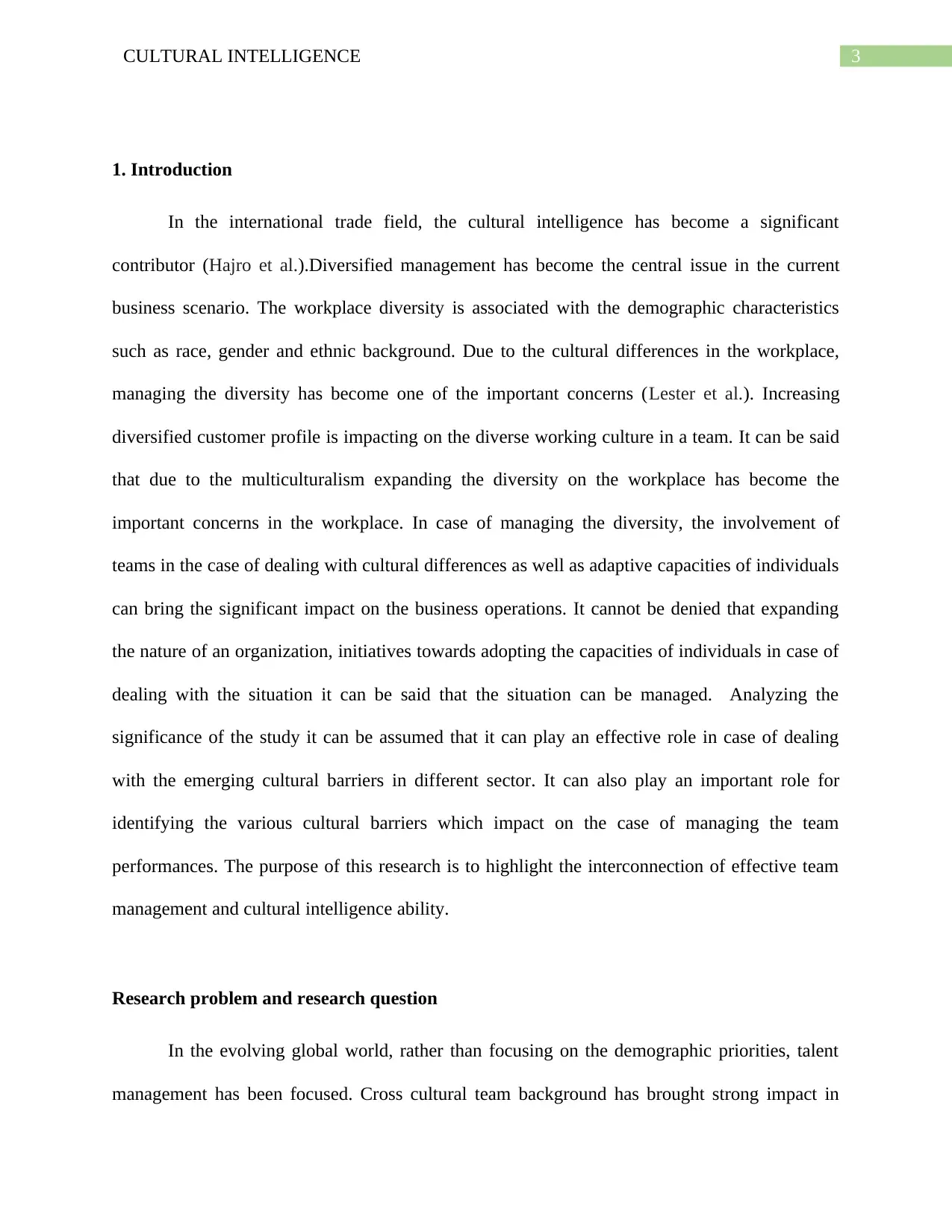
3CULTURAL INTELLIGENCE
1. Introduction
In the international trade field, the cultural intelligence has become a significant
contributor (Hajro et al.).Diversified management has become the central issue in the current
business scenario. The workplace diversity is associated with the demographic characteristics
such as race, gender and ethnic background. Due to the cultural differences in the workplace,
managing the diversity has become one of the important concerns (Lester et al.). Increasing
diversified customer profile is impacting on the diverse working culture in a team. It can be said
that due to the multiculturalism expanding the diversity on the workplace has become the
important concerns in the workplace. In case of managing the diversity, the involvement of
teams in the case of dealing with cultural differences as well as adaptive capacities of individuals
can bring the significant impact on the business operations. It cannot be denied that expanding
the nature of an organization, initiatives towards adopting the capacities of individuals in case of
dealing with the situation it can be said that the situation can be managed. Analyzing the
significance of the study it can be assumed that it can play an effective role in case of dealing
with the emerging cultural barriers in different sector. It can also play an important role for
identifying the various cultural barriers which impact on the case of managing the team
performances. The purpose of this research is to highlight the interconnection of effective team
management and cultural intelligence ability.
Research problem and research question
In the evolving global world, rather than focusing on the demographic priorities, talent
management has been focused. Cross cultural team background has brought strong impact in
1. Introduction
In the international trade field, the cultural intelligence has become a significant
contributor (Hajro et al.).Diversified management has become the central issue in the current
business scenario. The workplace diversity is associated with the demographic characteristics
such as race, gender and ethnic background. Due to the cultural differences in the workplace,
managing the diversity has become one of the important concerns (Lester et al.). Increasing
diversified customer profile is impacting on the diverse working culture in a team. It can be said
that due to the multiculturalism expanding the diversity on the workplace has become the
important concerns in the workplace. In case of managing the diversity, the involvement of
teams in the case of dealing with cultural differences as well as adaptive capacities of individuals
can bring the significant impact on the business operations. It cannot be denied that expanding
the nature of an organization, initiatives towards adopting the capacities of individuals in case of
dealing with the situation it can be said that the situation can be managed. Analyzing the
significance of the study it can be assumed that it can play an effective role in case of dealing
with the emerging cultural barriers in different sector. It can also play an important role for
identifying the various cultural barriers which impact on the case of managing the team
performances. The purpose of this research is to highlight the interconnection of effective team
management and cultural intelligence ability.
Research problem and research question
In the evolving global world, rather than focusing on the demographic priorities, talent
management has been focused. Cross cultural team background has brought strong impact in
Paraphrase This Document
Need a fresh take? Get an instant paraphrase of this document with our AI Paraphraser
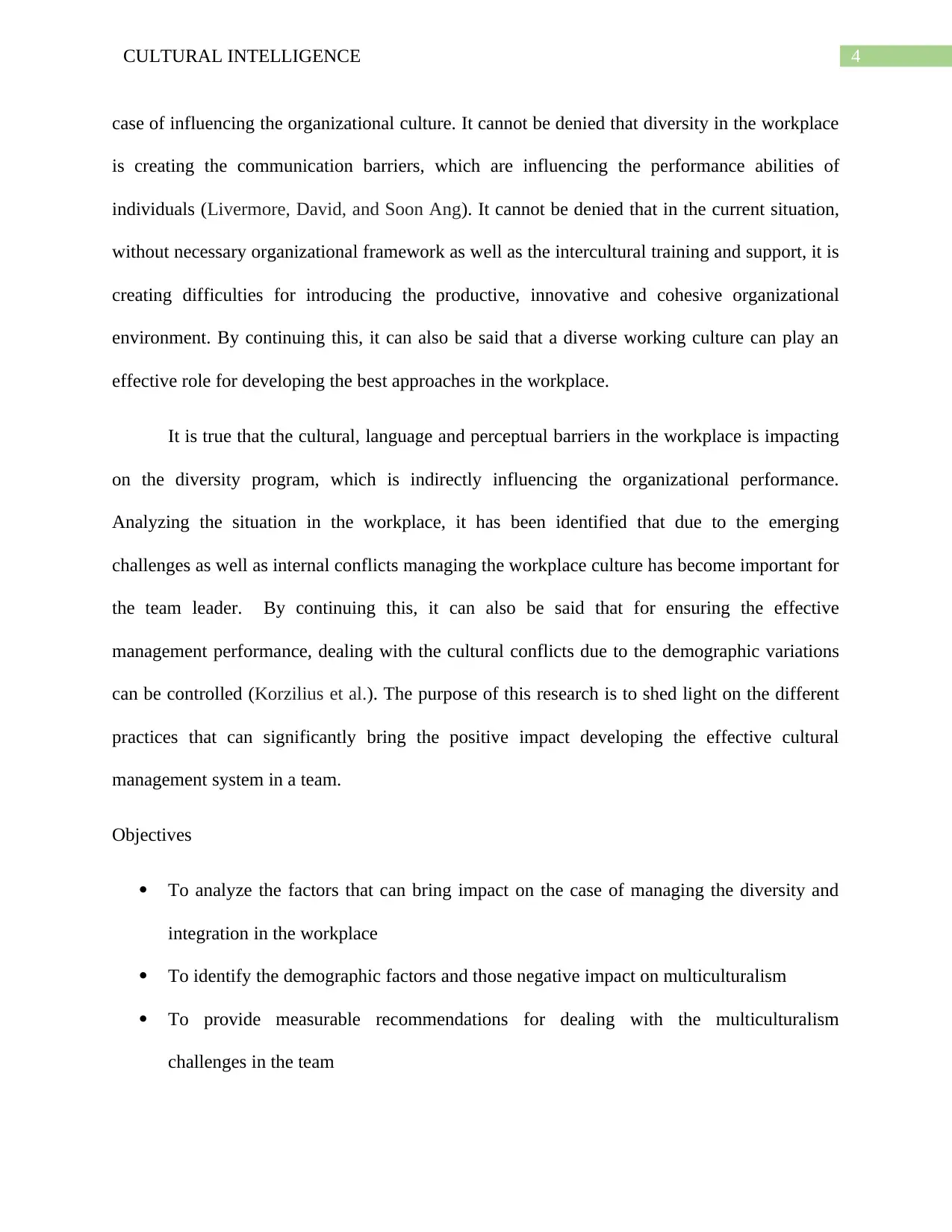
4CULTURAL INTELLIGENCE
case of influencing the organizational culture. It cannot be denied that diversity in the workplace
is creating the communication barriers, which are influencing the performance abilities of
individuals (Livermore, David, and Soon Ang). It cannot be denied that in the current situation,
without necessary organizational framework as well as the intercultural training and support, it is
creating difficulties for introducing the productive, innovative and cohesive organizational
environment. By continuing this, it can also be said that a diverse working culture can play an
effective role for developing the best approaches in the workplace.
It is true that the cultural, language and perceptual barriers in the workplace is impacting
on the diversity program, which is indirectly influencing the organizational performance.
Analyzing the situation in the workplace, it has been identified that due to the emerging
challenges as well as internal conflicts managing the workplace culture has become important for
the team leader. By continuing this, it can also be said that for ensuring the effective
management performance, dealing with the cultural conflicts due to the demographic variations
can be controlled (Korzilius et al.). The purpose of this research is to shed light on the different
practices that can significantly bring the positive impact developing the effective cultural
management system in a team.
Objectives
To analyze the factors that can bring impact on the case of managing the diversity and
integration in the workplace
To identify the demographic factors and those negative impact on multiculturalism
To provide measurable recommendations for dealing with the multiculturalism
challenges in the team
case of influencing the organizational culture. It cannot be denied that diversity in the workplace
is creating the communication barriers, which are influencing the performance abilities of
individuals (Livermore, David, and Soon Ang). It cannot be denied that in the current situation,
without necessary organizational framework as well as the intercultural training and support, it is
creating difficulties for introducing the productive, innovative and cohesive organizational
environment. By continuing this, it can also be said that a diverse working culture can play an
effective role for developing the best approaches in the workplace.
It is true that the cultural, language and perceptual barriers in the workplace is impacting
on the diversity program, which is indirectly influencing the organizational performance.
Analyzing the situation in the workplace, it has been identified that due to the emerging
challenges as well as internal conflicts managing the workplace culture has become important for
the team leader. By continuing this, it can also be said that for ensuring the effective
management performance, dealing with the cultural conflicts due to the demographic variations
can be controlled (Korzilius et al.). The purpose of this research is to shed light on the different
practices that can significantly bring the positive impact developing the effective cultural
management system in a team.
Objectives
To analyze the factors that can bring impact on the case of managing the diversity and
integration in the workplace
To identify the demographic factors and those negative impact on multiculturalism
To provide measurable recommendations for dealing with the multiculturalism
challenges in the team
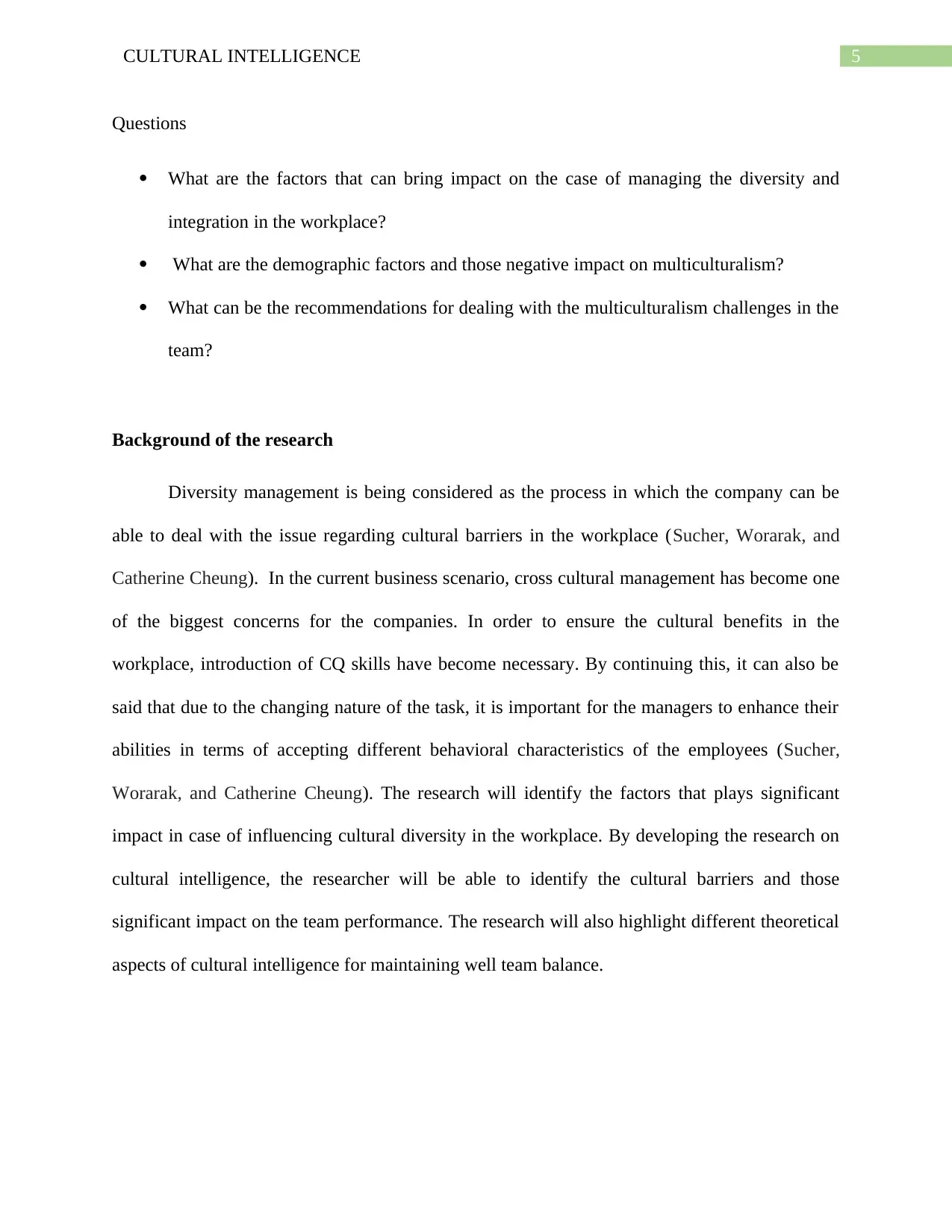
5CULTURAL INTELLIGENCE
Questions
What are the factors that can bring impact on the case of managing the diversity and
integration in the workplace?
What are the demographic factors and those negative impact on multiculturalism?
What can be the recommendations for dealing with the multiculturalism challenges in the
team?
Background of the research
Diversity management is being considered as the process in which the company can be
able to deal with the issue regarding cultural barriers in the workplace (Sucher, Worarak, and
Catherine Cheung). In the current business scenario, cross cultural management has become one
of the biggest concerns for the companies. In order to ensure the cultural benefits in the
workplace, introduction of CQ skills have become necessary. By continuing this, it can also be
said that due to the changing nature of the task, it is important for the managers to enhance their
abilities in terms of accepting different behavioral characteristics of the employees (Sucher,
Worarak, and Catherine Cheung). The research will identify the factors that plays significant
impact in case of influencing cultural diversity in the workplace. By developing the research on
cultural intelligence, the researcher will be able to identify the cultural barriers and those
significant impact on the team performance. The research will also highlight different theoretical
aspects of cultural intelligence for maintaining well team balance.
Questions
What are the factors that can bring impact on the case of managing the diversity and
integration in the workplace?
What are the demographic factors and those negative impact on multiculturalism?
What can be the recommendations for dealing with the multiculturalism challenges in the
team?
Background of the research
Diversity management is being considered as the process in which the company can be
able to deal with the issue regarding cultural barriers in the workplace (Sucher, Worarak, and
Catherine Cheung). In the current business scenario, cross cultural management has become one
of the biggest concerns for the companies. In order to ensure the cultural benefits in the
workplace, introduction of CQ skills have become necessary. By continuing this, it can also be
said that due to the changing nature of the task, it is important for the managers to enhance their
abilities in terms of accepting different behavioral characteristics of the employees (Sucher,
Worarak, and Catherine Cheung). The research will identify the factors that plays significant
impact in case of influencing cultural diversity in the workplace. By developing the research on
cultural intelligence, the researcher will be able to identify the cultural barriers and those
significant impact on the team performance. The research will also highlight different theoretical
aspects of cultural intelligence for maintaining well team balance.
⊘ This is a preview!⊘
Do you want full access?
Subscribe today to unlock all pages.

Trusted by 1+ million students worldwide
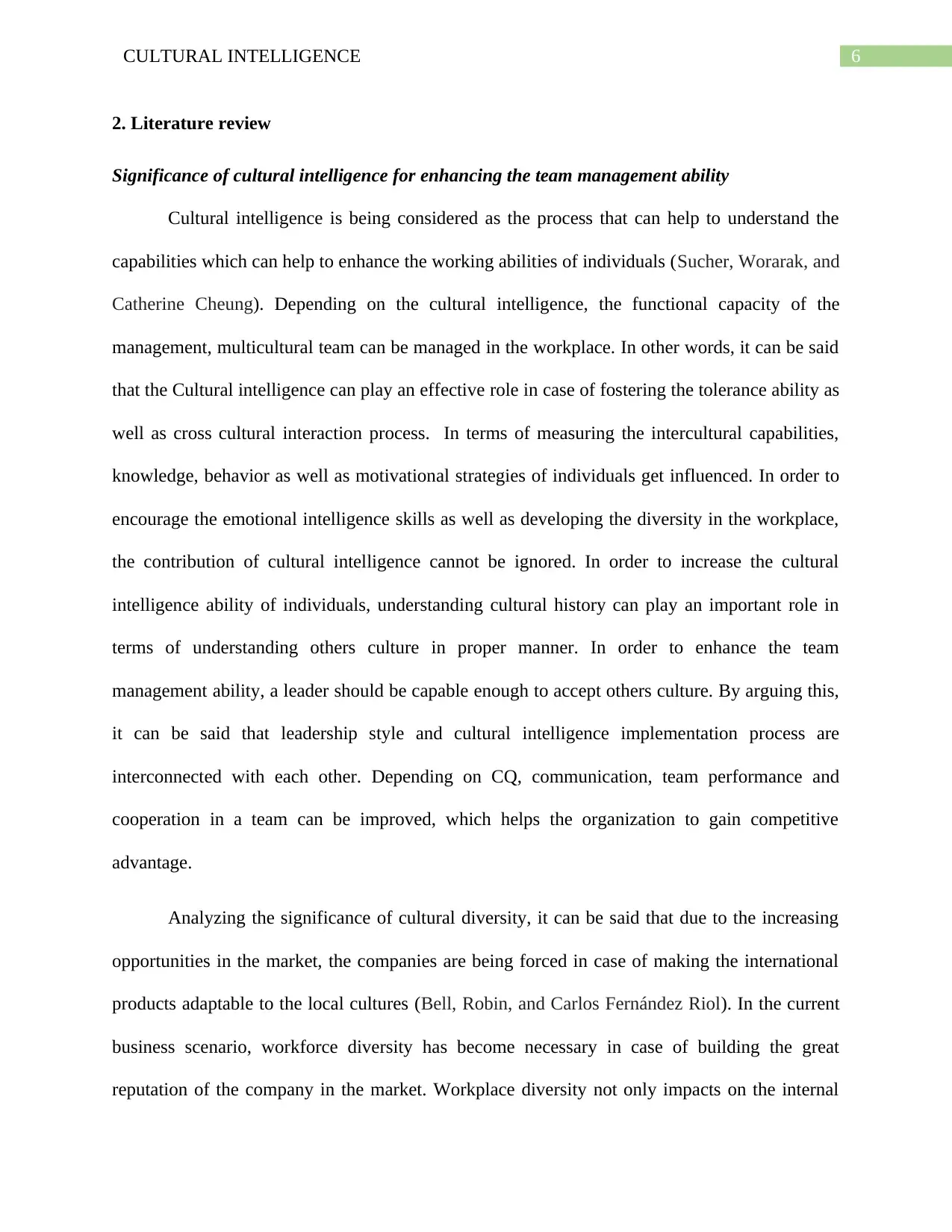
6CULTURAL INTELLIGENCE
2. Literature review
Significance of cultural intelligence for enhancing the team management ability
Cultural intelligence is being considered as the process that can help to understand the
capabilities which can help to enhance the working abilities of individuals (Sucher, Worarak, and
Catherine Cheung). Depending on the cultural intelligence, the functional capacity of the
management, multicultural team can be managed in the workplace. In other words, it can be said
that the Cultural intelligence can play an effective role in case of fostering the tolerance ability as
well as cross cultural interaction process. In terms of measuring the intercultural capabilities,
knowledge, behavior as well as motivational strategies of individuals get influenced. In order to
encourage the emotional intelligence skills as well as developing the diversity in the workplace,
the contribution of cultural intelligence cannot be ignored. In order to increase the cultural
intelligence ability of individuals, understanding cultural history can play an important role in
terms of understanding others culture in proper manner. In order to enhance the team
management ability, a leader should be capable enough to accept others culture. By arguing this,
it can be said that leadership style and cultural intelligence implementation process are
interconnected with each other. Depending on CQ, communication, team performance and
cooperation in a team can be improved, which helps the organization to gain competitive
advantage.
Analyzing the significance of cultural diversity, it can be said that due to the increasing
opportunities in the market, the companies are being forced in case of making the international
products adaptable to the local cultures (Bell, Robin, and Carlos Fernández Riol). In the current
business scenario, workforce diversity has become necessary in case of building the great
reputation of the company in the market. Workplace diversity not only impacts on the internal
2. Literature review
Significance of cultural intelligence for enhancing the team management ability
Cultural intelligence is being considered as the process that can help to understand the
capabilities which can help to enhance the working abilities of individuals (Sucher, Worarak, and
Catherine Cheung). Depending on the cultural intelligence, the functional capacity of the
management, multicultural team can be managed in the workplace. In other words, it can be said
that the Cultural intelligence can play an effective role in case of fostering the tolerance ability as
well as cross cultural interaction process. In terms of measuring the intercultural capabilities,
knowledge, behavior as well as motivational strategies of individuals get influenced. In order to
encourage the emotional intelligence skills as well as developing the diversity in the workplace,
the contribution of cultural intelligence cannot be ignored. In order to increase the cultural
intelligence ability of individuals, understanding cultural history can play an important role in
terms of understanding others culture in proper manner. In order to enhance the team
management ability, a leader should be capable enough to accept others culture. By arguing this,
it can be said that leadership style and cultural intelligence implementation process are
interconnected with each other. Depending on CQ, communication, team performance and
cooperation in a team can be improved, which helps the organization to gain competitive
advantage.
Analyzing the significance of cultural diversity, it can be said that due to the increasing
opportunities in the market, the companies are being forced in case of making the international
products adaptable to the local cultures (Bell, Robin, and Carlos Fernández Riol). In the current
business scenario, workforce diversity has become necessary in case of building the great
reputation of the company in the market. Workplace diversity not only impacts on the internal
Paraphrase This Document
Need a fresh take? Get an instant paraphrase of this document with our AI Paraphraser
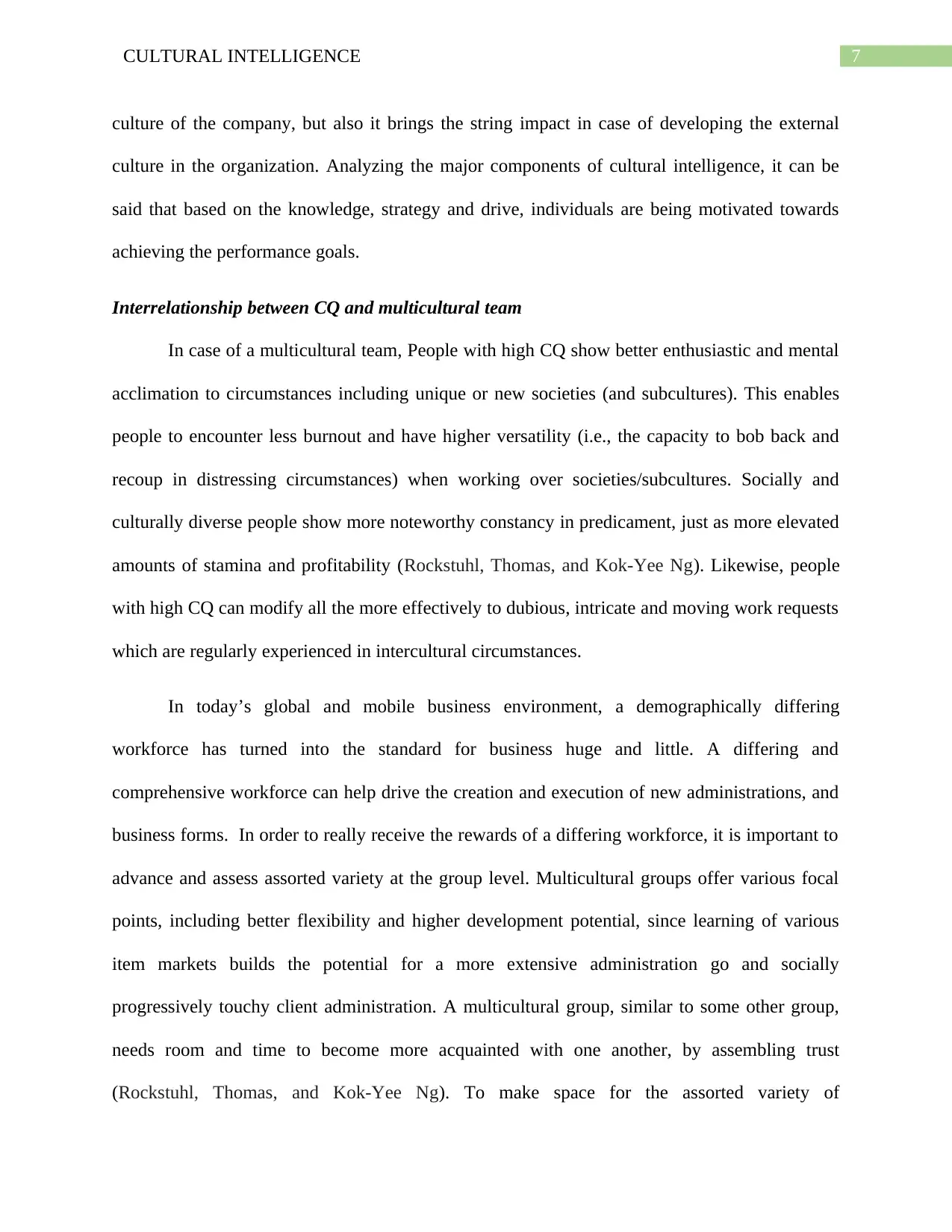
7CULTURAL INTELLIGENCE
culture of the company, but also it brings the string impact in case of developing the external
culture in the organization. Analyzing the major components of cultural intelligence, it can be
said that based on the knowledge, strategy and drive, individuals are being motivated towards
achieving the performance goals.
Interrelationship between CQ and multicultural team
In case of a multicultural team, People with high CQ show better enthusiastic and mental
acclimation to circumstances including unique or new societies (and subcultures). This enables
people to encounter less burnout and have higher versatility (i.e., the capacity to bob back and
recoup in distressing circumstances) when working over societies/subcultures. Socially and
culturally diverse people show more noteworthy constancy in predicament, just as more elevated
amounts of stamina and profitability (Rockstuhl, Thomas, and Kok-Yee Ng). Likewise, people
with high CQ can modify all the more effectively to dubious, intricate and moving work requests
which are regularly experienced in intercultural circumstances.
In today’s global and mobile business environment, a demographically differing
workforce has turned into the standard for business huge and little. A differing and
comprehensive workforce can help drive the creation and execution of new administrations, and
business forms. In order to really receive the rewards of a differing workforce, it is important to
advance and assess assorted variety at the group level. Multicultural groups offer various focal
points, including better flexibility and higher development potential, since learning of various
item markets builds the potential for a more extensive administration go and socially
progressively touchy client administration. A multicultural group, similar to some other group,
needs room and time to become more acquainted with one another, by assembling trust
(Rockstuhl, Thomas, and Kok-Yee Ng). To make space for the assorted variety of
culture of the company, but also it brings the string impact in case of developing the external
culture in the organization. Analyzing the major components of cultural intelligence, it can be
said that based on the knowledge, strategy and drive, individuals are being motivated towards
achieving the performance goals.
Interrelationship between CQ and multicultural team
In case of a multicultural team, People with high CQ show better enthusiastic and mental
acclimation to circumstances including unique or new societies (and subcultures). This enables
people to encounter less burnout and have higher versatility (i.e., the capacity to bob back and
recoup in distressing circumstances) when working over societies/subcultures. Socially and
culturally diverse people show more noteworthy constancy in predicament, just as more elevated
amounts of stamina and profitability (Rockstuhl, Thomas, and Kok-Yee Ng). Likewise, people
with high CQ can modify all the more effectively to dubious, intricate and moving work requests
which are regularly experienced in intercultural circumstances.
In today’s global and mobile business environment, a demographically differing
workforce has turned into the standard for business huge and little. A differing and
comprehensive workforce can help drive the creation and execution of new administrations, and
business forms. In order to really receive the rewards of a differing workforce, it is important to
advance and assess assorted variety at the group level. Multicultural groups offer various focal
points, including better flexibility and higher development potential, since learning of various
item markets builds the potential for a more extensive administration go and socially
progressively touchy client administration. A multicultural group, similar to some other group,
needs room and time to become more acquainted with one another, by assembling trust
(Rockstuhl, Thomas, and Kok-Yee Ng). To make space for the assorted variety of
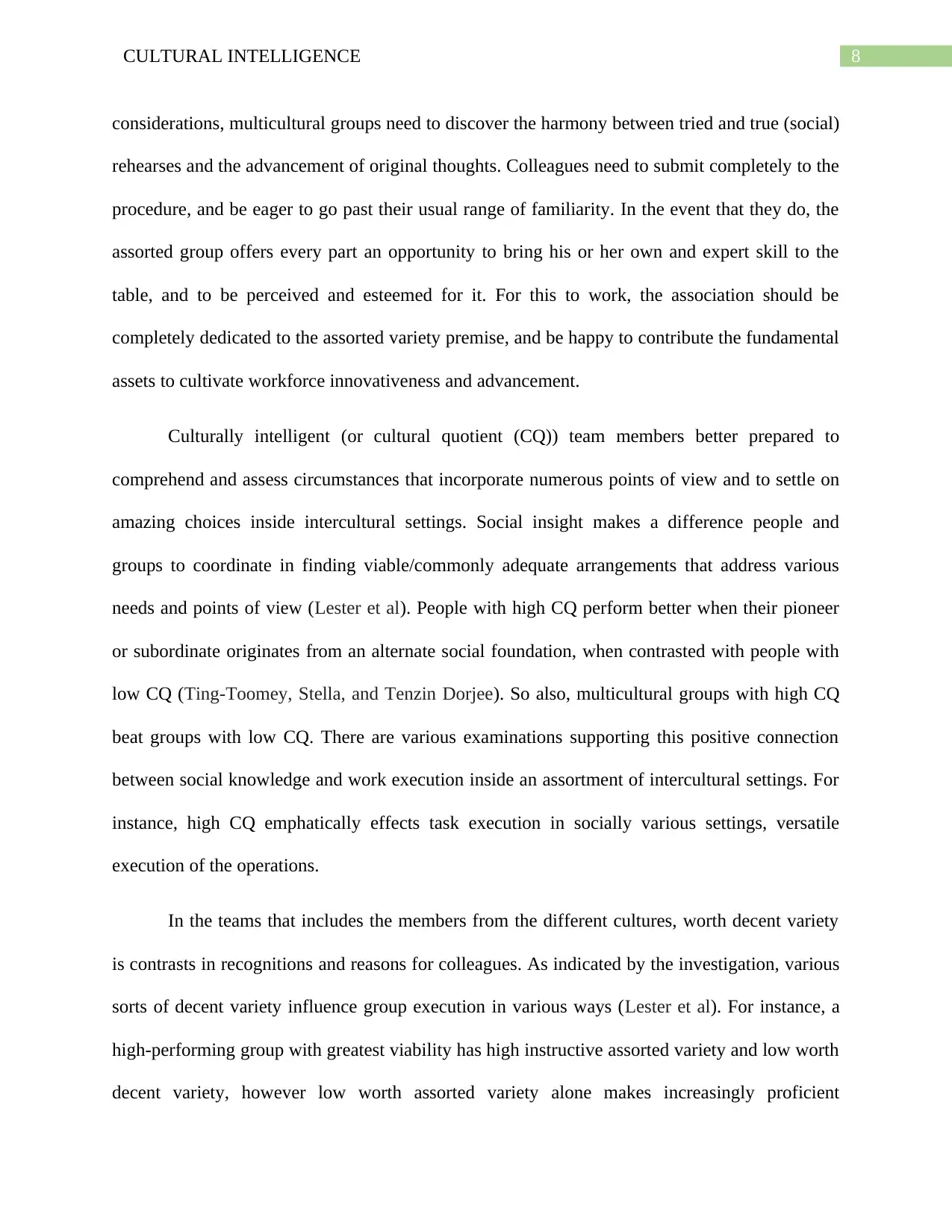
8CULTURAL INTELLIGENCE
considerations, multicultural groups need to discover the harmony between tried and true (social)
rehearses and the advancement of original thoughts. Colleagues need to submit completely to the
procedure, and be eager to go past their usual range of familiarity. In the event that they do, the
assorted group offers every part an opportunity to bring his or her own and expert skill to the
table, and to be perceived and esteemed for it. For this to work, the association should be
completely dedicated to the assorted variety premise, and be happy to contribute the fundamental
assets to cultivate workforce innovativeness and advancement.
Culturally intelligent (or cultural quotient (CQ)) team members better prepared to
comprehend and assess circumstances that incorporate numerous points of view and to settle on
amazing choices inside intercultural settings. Social insight makes a difference people and
groups to coordinate in finding viable/commonly adequate arrangements that address various
needs and points of view (Lester et al). People with high CQ perform better when their pioneer
or subordinate originates from an alternate social foundation, when contrasted with people with
low CQ (Ting-Toomey, Stella, and Tenzin Dorjee). So also, multicultural groups with high CQ
beat groups with low CQ. There are various examinations supporting this positive connection
between social knowledge and work execution inside an assortment of intercultural settings. For
instance, high CQ emphatically effects task execution in socially various settings, versatile
execution of the operations.
In the teams that includes the members from the different cultures, worth decent variety
is contrasts in recognitions and reasons for colleagues. As indicated by the investigation, various
sorts of decent variety influence group execution in various ways (Lester et al). For instance, a
high-performing group with greatest viability has high instructive assorted variety and low worth
decent variety, however low worth assorted variety alone makes increasingly proficient
considerations, multicultural groups need to discover the harmony between tried and true (social)
rehearses and the advancement of original thoughts. Colleagues need to submit completely to the
procedure, and be eager to go past their usual range of familiarity. In the event that they do, the
assorted group offers every part an opportunity to bring his or her own and expert skill to the
table, and to be perceived and esteemed for it. For this to work, the association should be
completely dedicated to the assorted variety premise, and be happy to contribute the fundamental
assets to cultivate workforce innovativeness and advancement.
Culturally intelligent (or cultural quotient (CQ)) team members better prepared to
comprehend and assess circumstances that incorporate numerous points of view and to settle on
amazing choices inside intercultural settings. Social insight makes a difference people and
groups to coordinate in finding viable/commonly adequate arrangements that address various
needs and points of view (Lester et al). People with high CQ perform better when their pioneer
or subordinate originates from an alternate social foundation, when contrasted with people with
low CQ (Ting-Toomey, Stella, and Tenzin Dorjee). So also, multicultural groups with high CQ
beat groups with low CQ. There are various examinations supporting this positive connection
between social knowledge and work execution inside an assortment of intercultural settings. For
instance, high CQ emphatically effects task execution in socially various settings, versatile
execution of the operations.
In the teams that includes the members from the different cultures, worth decent variety
is contrasts in recognitions and reasons for colleagues. As indicated by the investigation, various
sorts of decent variety influence group execution in various ways (Lester et al). For instance, a
high-performing group with greatest viability has high instructive assorted variety and low worth
decent variety, however low worth assorted variety alone makes increasingly proficient
⊘ This is a preview!⊘
Do you want full access?
Subscribe today to unlock all pages.

Trusted by 1+ million students worldwide
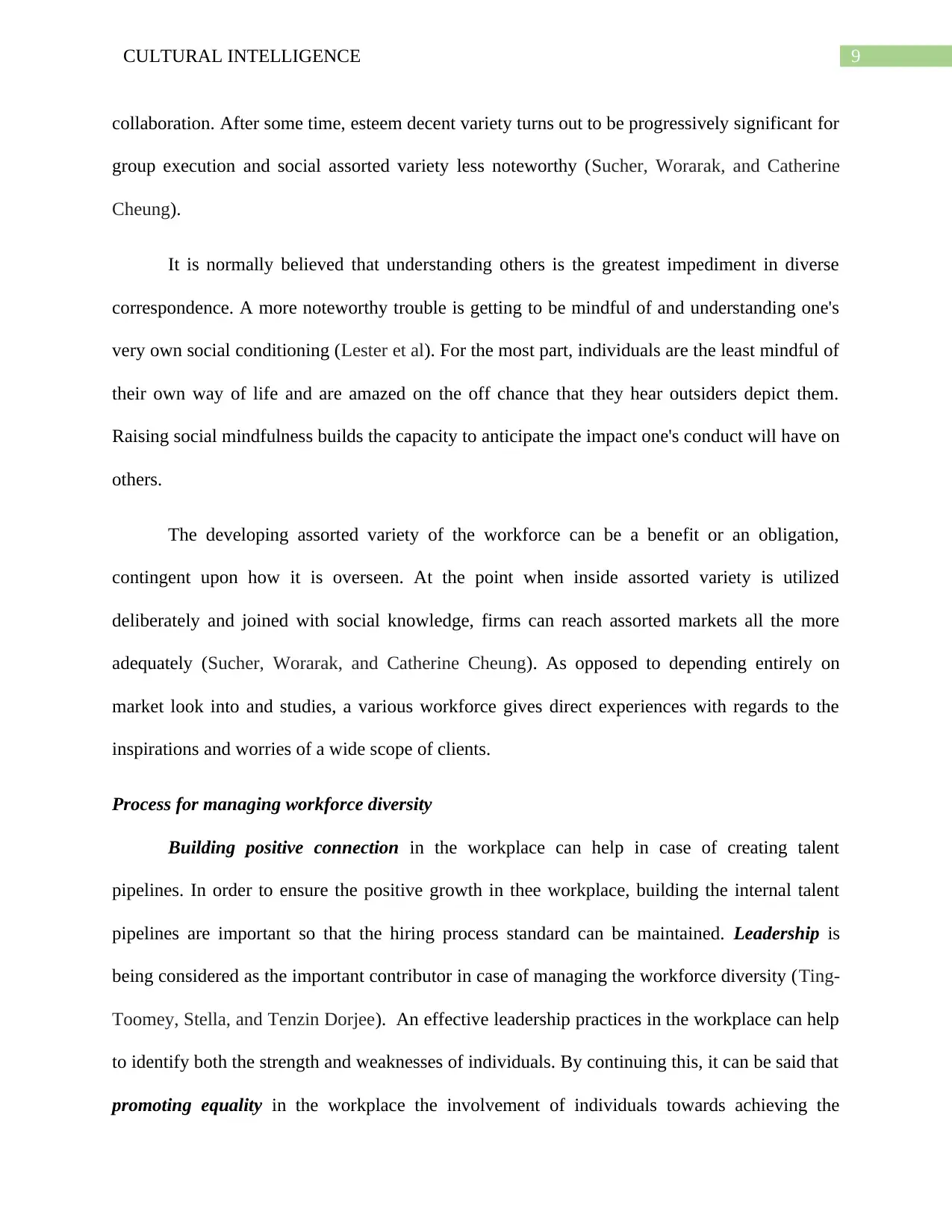
9CULTURAL INTELLIGENCE
collaboration. After some time, esteem decent variety turns out to be progressively significant for
group execution and social assorted variety less noteworthy (Sucher, Worarak, and Catherine
Cheung).
It is normally believed that understanding others is the greatest impediment in diverse
correspondence. A more noteworthy trouble is getting to be mindful of and understanding one's
very own social conditioning (Lester et al). For the most part, individuals are the least mindful of
their own way of life and are amazed on the off chance that they hear outsiders depict them.
Raising social mindfulness builds the capacity to anticipate the impact one's conduct will have on
others.
The developing assorted variety of the workforce can be a benefit or an obligation,
contingent upon how it is overseen. At the point when inside assorted variety is utilized
deliberately and joined with social knowledge, firms can reach assorted markets all the more
adequately (Sucher, Worarak, and Catherine Cheung). As opposed to depending entirely on
market look into and studies, a various workforce gives direct experiences with regards to the
inspirations and worries of a wide scope of clients.
Process for managing workforce diversity
Building positive connection in the workplace can help in case of creating talent
pipelines. In order to ensure the positive growth in thee workplace, building the internal talent
pipelines are important so that the hiring process standard can be maintained. Leadership is
being considered as the important contributor in case of managing the workforce diversity (Ting-
Toomey, Stella, and Tenzin Dorjee). An effective leadership practices in the workplace can help
to identify both the strength and weaknesses of individuals. By continuing this, it can be said that
promoting equality in the workplace the involvement of individuals towards achieving the
collaboration. After some time, esteem decent variety turns out to be progressively significant for
group execution and social assorted variety less noteworthy (Sucher, Worarak, and Catherine
Cheung).
It is normally believed that understanding others is the greatest impediment in diverse
correspondence. A more noteworthy trouble is getting to be mindful of and understanding one's
very own social conditioning (Lester et al). For the most part, individuals are the least mindful of
their own way of life and are amazed on the off chance that they hear outsiders depict them.
Raising social mindfulness builds the capacity to anticipate the impact one's conduct will have on
others.
The developing assorted variety of the workforce can be a benefit or an obligation,
contingent upon how it is overseen. At the point when inside assorted variety is utilized
deliberately and joined with social knowledge, firms can reach assorted markets all the more
adequately (Sucher, Worarak, and Catherine Cheung). As opposed to depending entirely on
market look into and studies, a various workforce gives direct experiences with regards to the
inspirations and worries of a wide scope of clients.
Process for managing workforce diversity
Building positive connection in the workplace can help in case of creating talent
pipelines. In order to ensure the positive growth in thee workplace, building the internal talent
pipelines are important so that the hiring process standard can be maintained. Leadership is
being considered as the important contributor in case of managing the workforce diversity (Ting-
Toomey, Stella, and Tenzin Dorjee). An effective leadership practices in the workplace can help
to identify both the strength and weaknesses of individuals. By continuing this, it can be said that
promoting equality in the workplace the involvement of individuals towards achieving the
Paraphrase This Document
Need a fresh take? Get an instant paraphrase of this document with our AI Paraphraser
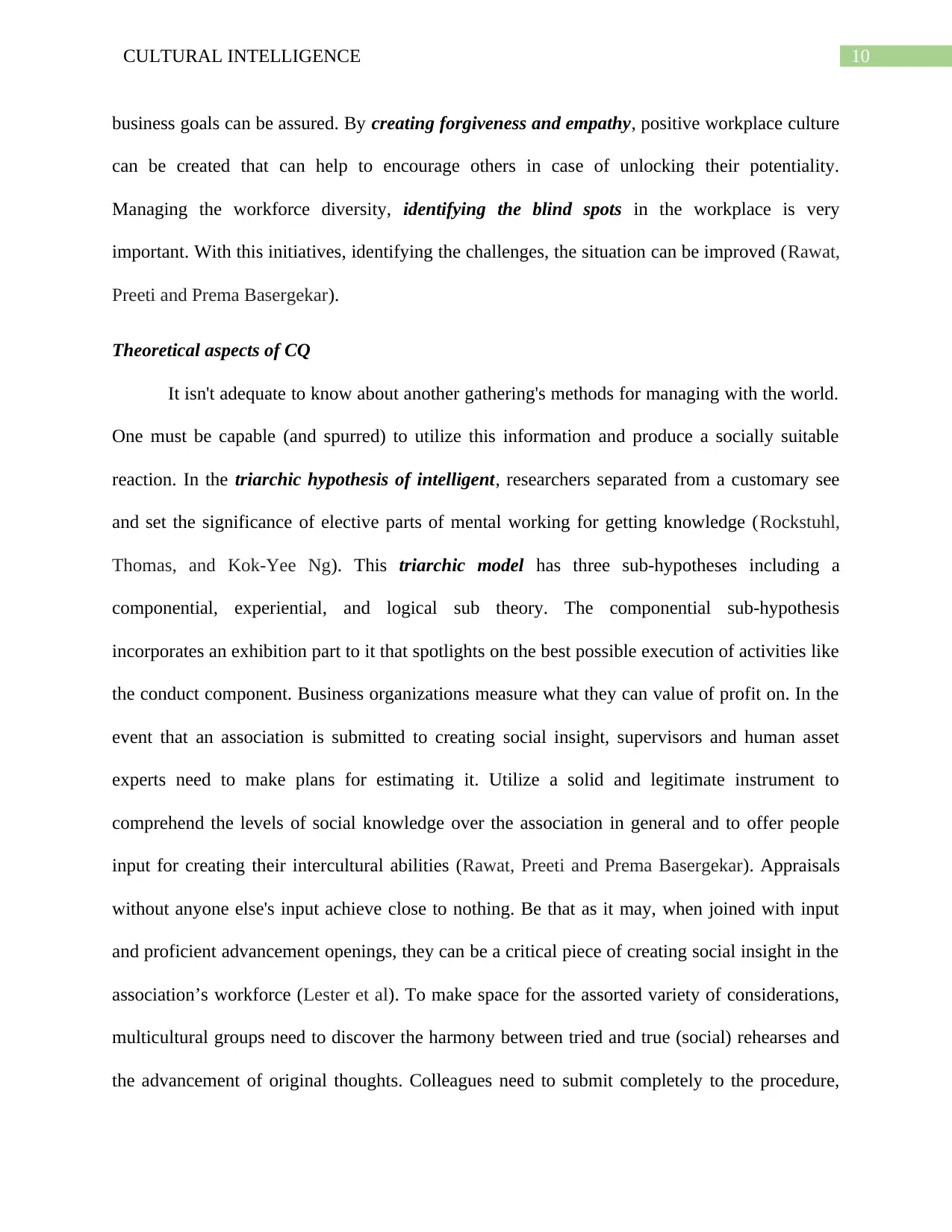
10CULTURAL INTELLIGENCE
business goals can be assured. By creating forgiveness and empathy, positive workplace culture
can be created that can help to encourage others in case of unlocking their potentiality.
Managing the workforce diversity, identifying the blind spots in the workplace is very
important. With this initiatives, identifying the challenges, the situation can be improved (Rawat,
Preeti and Prema Basergekar).
Theoretical aspects of CQ
It isn't adequate to know about another gathering's methods for managing with the world.
One must be capable (and spurred) to utilize this information and produce a socially suitable
reaction. In the triarchic hypothesis of intelligent, researchers separated from a customary see
and set the significance of elective parts of mental working for getting knowledge (Rockstuhl,
Thomas, and Kok-Yee Ng). This triarchic model has three sub-hypotheses including a
componential, experiential, and logical sub theory. The componential sub-hypothesis
incorporates an exhibition part to it that spotlights on the best possible execution of activities like
the conduct component. Business organizations measure what they can value of profit on. In the
event that an association is submitted to creating social insight, supervisors and human asset
experts need to make plans for estimating it. Utilize a solid and legitimate instrument to
comprehend the levels of social knowledge over the association in general and to offer people
input for creating their intercultural abilities (Rawat, Preeti and Prema Basergekar). Appraisals
without anyone else's input achieve close to nothing. Be that as it may, when joined with input
and proficient advancement openings, they can be a critical piece of creating social insight in the
association’s workforce (Lester et al). To make space for the assorted variety of considerations,
multicultural groups need to discover the harmony between tried and true (social) rehearses and
the advancement of original thoughts. Colleagues need to submit completely to the procedure,
business goals can be assured. By creating forgiveness and empathy, positive workplace culture
can be created that can help to encourage others in case of unlocking their potentiality.
Managing the workforce diversity, identifying the blind spots in the workplace is very
important. With this initiatives, identifying the challenges, the situation can be improved (Rawat,
Preeti and Prema Basergekar).
Theoretical aspects of CQ
It isn't adequate to know about another gathering's methods for managing with the world.
One must be capable (and spurred) to utilize this information and produce a socially suitable
reaction. In the triarchic hypothesis of intelligent, researchers separated from a customary see
and set the significance of elective parts of mental working for getting knowledge (Rockstuhl,
Thomas, and Kok-Yee Ng). This triarchic model has three sub-hypotheses including a
componential, experiential, and logical sub theory. The componential sub-hypothesis
incorporates an exhibition part to it that spotlights on the best possible execution of activities like
the conduct component. Business organizations measure what they can value of profit on. In the
event that an association is submitted to creating social insight, supervisors and human asset
experts need to make plans for estimating it. Utilize a solid and legitimate instrument to
comprehend the levels of social knowledge over the association in general and to offer people
input for creating their intercultural abilities (Rawat, Preeti and Prema Basergekar). Appraisals
without anyone else's input achieve close to nothing. Be that as it may, when joined with input
and proficient advancement openings, they can be a critical piece of creating social insight in the
association’s workforce (Lester et al). To make space for the assorted variety of considerations,
multicultural groups need to discover the harmony between tried and true (social) rehearses and
the advancement of original thoughts. Colleagues need to submit completely to the procedure,
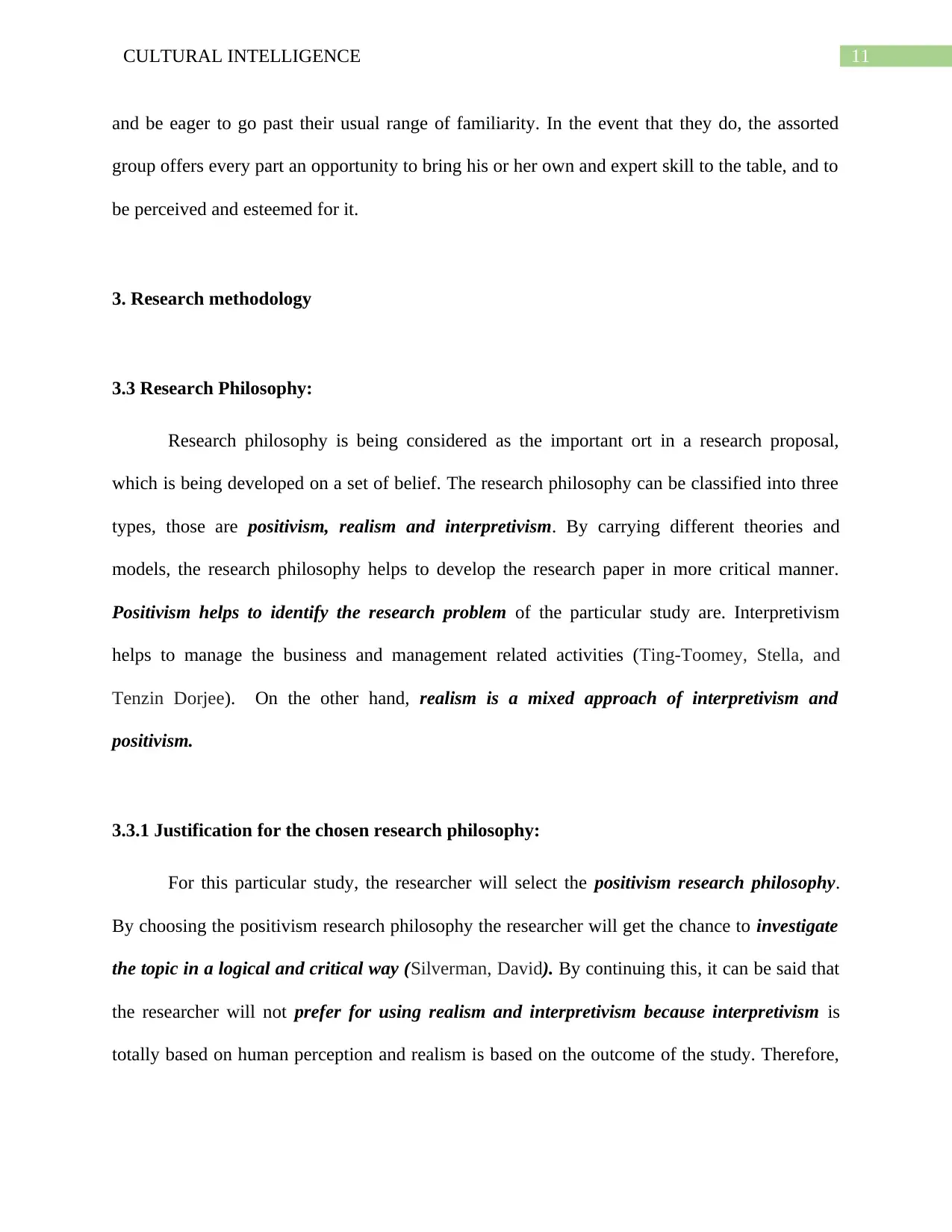
11CULTURAL INTELLIGENCE
and be eager to go past their usual range of familiarity. In the event that they do, the assorted
group offers every part an opportunity to bring his or her own and expert skill to the table, and to
be perceived and esteemed for it.
3. Research methodology
3.3 Research Philosophy:
Research philosophy is being considered as the important ort in a research proposal,
which is being developed on a set of belief. The research philosophy can be classified into three
types, those are positivism, realism and interpretivism. By carrying different theories and
models, the research philosophy helps to develop the research paper in more critical manner.
Positivism helps to identify the research problem of the particular study are. Interpretivism
helps to manage the business and management related activities (Ting-Toomey, Stella, and
Tenzin Dorjee). On the other hand, realism is a mixed approach of interpretivism and
positivism.
3.3.1 Justification for the chosen research philosophy:
For this particular study, the researcher will select the positivism research philosophy.
By choosing the positivism research philosophy the researcher will get the chance to investigate
the topic in a logical and critical way (Silverman, David). By continuing this, it can be said that
the researcher will not prefer for using realism and interpretivism because interpretivism is
totally based on human perception and realism is based on the outcome of the study. Therefore,
and be eager to go past their usual range of familiarity. In the event that they do, the assorted
group offers every part an opportunity to bring his or her own and expert skill to the table, and to
be perceived and esteemed for it.
3. Research methodology
3.3 Research Philosophy:
Research philosophy is being considered as the important ort in a research proposal,
which is being developed on a set of belief. The research philosophy can be classified into three
types, those are positivism, realism and interpretivism. By carrying different theories and
models, the research philosophy helps to develop the research paper in more critical manner.
Positivism helps to identify the research problem of the particular study are. Interpretivism
helps to manage the business and management related activities (Ting-Toomey, Stella, and
Tenzin Dorjee). On the other hand, realism is a mixed approach of interpretivism and
positivism.
3.3.1 Justification for the chosen research philosophy:
For this particular study, the researcher will select the positivism research philosophy.
By choosing the positivism research philosophy the researcher will get the chance to investigate
the topic in a logical and critical way (Silverman, David). By continuing this, it can be said that
the researcher will not prefer for using realism and interpretivism because interpretivism is
totally based on human perception and realism is based on the outcome of the study. Therefore,
⊘ This is a preview!⊘
Do you want full access?
Subscribe today to unlock all pages.

Trusted by 1+ million students worldwide
1 out of 18
Related Documents
Your All-in-One AI-Powered Toolkit for Academic Success.
+13062052269
info@desklib.com
Available 24*7 on WhatsApp / Email
![[object Object]](/_next/static/media/star-bottom.7253800d.svg)
Unlock your academic potential
Copyright © 2020–2025 A2Z Services. All Rights Reserved. Developed and managed by ZUCOL.




